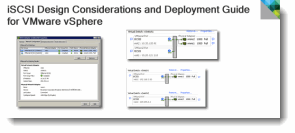Newly updated white paper by VMware is all about design and deployment of vSphere on iSCSI storage, which is the most used by smaller and bigger customers. It's a document which has been updated last week called iSCSI Design Consideration and Deployment guide teaches the best practices for running VMware vSphere on iSCSI storage. Authored by Cormac Hogan ( @VMwareStorage ) who works for VMware as a senior technical marketing architect.
To present block storage device via the network to vSphere hosts, iSCSI protocol is used. Since vSphere 5.0 the multi-nic GUI interface is supported, which eases the settings, but it's always important to keep up to date with the latest developments of vSphere and iSCSI protocols, so the best practices actually might changes depending of the version of vSphere you're using. This is not something new and applies not only to iSCSI but storage and vSphere in general.
A quote from the paper:
A best practice for iSCSI is to avoid the vSphere feature called teaming (on the network interface cards) and instead use port binding. Port binding introduces multipathing for availability of access to the iSCSI targets and LUNs. If for some reason this is not suitable (for instance, you wish to route traffic between the iSCSI initiator and target), then teaming might be an alternative.

When using two two vSwitches, there isn't a problem with that.
You can download the paper from this page:
- VMware Technical papers – iSCSI Design Considerations and Deployment Guide
Also recommended is the iSCSI multipathing paper from this link.
You might want to check my Free technical PDF page where you'll find more technical papers from my partners.
